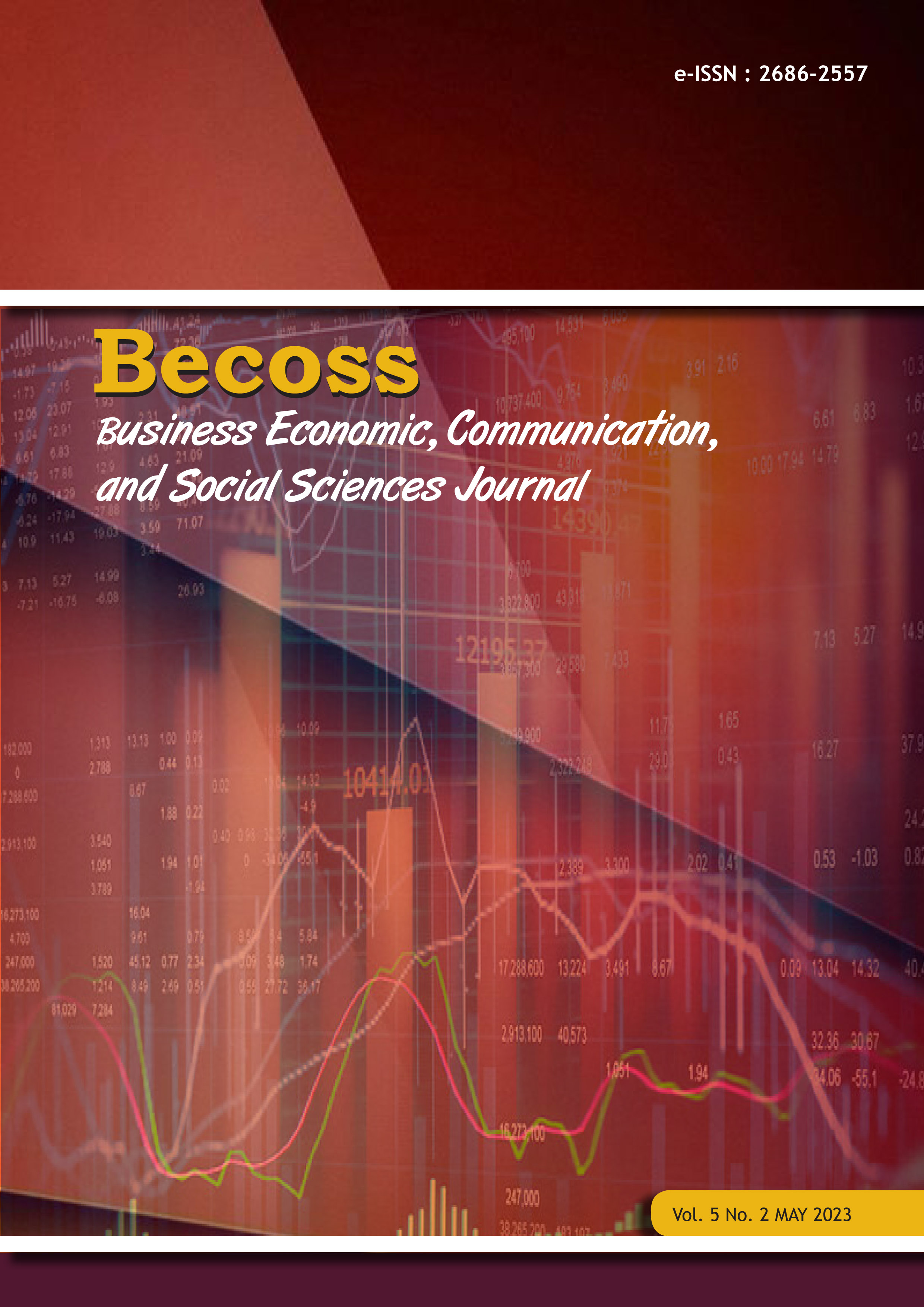The Effect of Toxic Workplace Environment on Employee Performance Mediated by Employee Engagement and Work Stress Among F&B Employees in Jakarta
DOI:
https://doi.org/10.21512/becossjournal.v5i2.9729Keywords:
Toxic workplace environment, Employee Performance, Employee Engagement, Work StressAbstract
Employee engagement and high work stress often become obstacles for MSMEs to produce good employee performance. One of the problems in human resources that often occur is a toxic workplace environment. The purpose of this study was to determine the effect of a toxic workplace environment on employee performance mediated by work stress and employee engagement among F&B MSMEs employees in Jakarta. This research uses quantitative research methods. Questionnaires were distributed to F&B MSMEs employees in Jakarta and the data obtained was processed using SmartPLS. This study has a respondent of 400 respondents. The results showed that there was a positive effect between a toxic workplace environment on work stress, a negative effect between a toxic workplace environment on employee engagement, a negative effect between work stress and employee performance, a positive effect between employee engagement and employee performance, a non-significant negative effect of a toxic workplace environment on employee performance, there is a significant negative effect of a toxic workplace environment mediated by work stress on employee performance, and there is a significant negative effect of a toxic workplace environment mediated by employee engagement on employee performance.
References
Bayu, D. J. (2021, January 21). Pelaku UMKM Masih Pesimis Bisnisnya Meningkat pada Awal 2021. Retrieved from Databoks: https://databoks.katadata.co.id/datapublish/2021/01/21/pelaku-umkm-masih-pesimis-bisnisnya-meningkat-pada-awal-2021
Haeruddin, M. I., Akbar, A., Dipoatmodjo, T. S., Kurniawan, A. W., & Abadi, R. R. (2022). The Toxicity of our City: The Effect of Toxic Workplace Environment on Employee’s Performance. International Journal of Social Science and Business , 6(2), 183-190.
Haryanti, D. M. (2018, July 24). Potret UMKM Indonesia: Si Kecil yang Berperan Besar. Retrieved from UKMINDONESIA.ID: https://ukmindonesia.id/baca-deskripsi-posts/potret-umkm-indonesia-si-kecil-yang-berperan-besar
Hoque, A. S., Awang, Z. B., Siddiqui, B. A., & Sabiu, M. S. (2018). Role of Employee Engagement on Compensation System and Employee Performance Relationship among Telecommunication Service Providers in Bangladesh. International Journal of Human Resource Studies , 8(3), 19-37.
Limanseto, H. (2022, October 1). Perkembangan UMKM sebagai Critical Engine Perekonomian Nasional Terus Mendapatkan Dukungan Pemerintah. Retrieved from https://www.ekon.go.id/publikasi/detail/4593/perkembangan-umkm-sebagai-critical-engine-perekonomian-nasional-terus-mendapatkan-dukungan-pemerintah
Masliani, A. (2021, December 9). Banyak Terjadi di Dunia Kerja! Toxic Workplace Environment dan Cara Menghadapinya. Retrieved from Frekuensinews.com: https://www.frekuensinews.com/pendidikan/pr-2892090673/banyak-terjadi-di-dunia-kerja-toxic-workplace-environment-dan-cara-menghadapinya
Mughal, M. U. (2020). The Impact of Leadership, Teamwork and Employee Engagement on Employee Performances. Saudi Journal of Business and Management Studies , 5(3), 233-244.
Muhson, A. (2022). Analisis Statistik dengan SmartPLS: Path Analysis, Confirmatory Factor Analysis, & Structural Equation Modeling. Universitas Negeri Yogyakarta.
Pusparisa, Y. (2020, September 28). Enam Sebab UMKM Membatasi hingga Menutup Operasional Usaha. Retrieved from Databoks: https://databoks.katadata.co.id/datapublish/2020/09/28/enam-sebab-umkm-membatasi-hingga-menutup-operasional-usaha
Rasool, S. F., Wang, M., Tang, M., Saeed, A., & Iqbal, J. (2021). How Toxic Workplace Environment Effects the Employee Engagement: The Mediating Role of Organizational Support and Employee Wellbeing. International Journal of Environmental Research and Public Health , 18(2294).
Rasool, S. F., Wang, M., Zhang, Y., & Samma, M. (2020). Sustainable Work Performance: The Roles of Workplace Violence and Occupational Stress. International Journal of Environmental Research and Public Health , 17, 912.
Rizki, M., Arhami, M., & Huzeni. (2021). Perbaikan Algoritma Naive Bayes Classifier Menggunakan Teknik Laplacian Correction. Jurnal Teknologi , 21(1), 39-45.
Teo, S. T., Bentley, T., & Nguyen, D. (2020). Psychosocial work environment, work engagement, and employee commitment: A moderated, mediation model. International Journal of Hospitality Management , 88, 1-10.
Uakarn, C., Chaokromthong, K., & Sintao, N. (2021). Sample Size Estimation using Yamane and Cochran and Krejcie and Morgan and Green Formulas and Cohen Statistical Power Analysis by G*Power and Comparisons. Apheit International Journal , 10(2), 76-88.
Wan, Q., Li, Z., Zhou, W., & Shang, S. (2018). Effects of work environment and job characteristics on the turnover intention of experienced nurses: The mediating role of work engagement. Journal of advanced nursing , 74(6), 1332-1341.
Wang, Z., Zaman, S., Rasool, S. F., Zaman, Q. u., & Amin, A. (2020). Exploring the Relationships Between a Toxic Workplace Environment, Workplace Stress, and Project Success with the Moderating Effect of Organizational Support: Empirical Evidence from Pakistan. Risk Manage Health Policy , 13, 1055-1067.
Wirotama, S. (2022). Budaya Toxic: Red Flag Untuk Kinerja Organisasi. Retrieved from https://samahita.co.id/budaya-toxic-red-flag-untuk-kinerja-organisasi/
Yu, J., Park, J., & Hyun, S. S. (2021). Impacts of the COVID-19 pandemic on employees’ work stress, well-being, mental health, organizational citizenship behavior, and employee- customer identification. Journal of Hospitality Marketing & Management , 30(5), 529-548.
Downloads
Published
How to Cite
Issue
Section
License
Copyright (c) 2023 Business Economic, Communication, and Social Sciences (BECOSS) Journal

This work is licensed under a Creative Commons Attribution-ShareAlike 4.0 International License.
Authors who publish with this journal agree to the following terms:
- Authors retain copyright and grant the journal right of first publication with the work simultaneously licensed under a Creative Commons Attribution License - Share Alike that allows others to share the work with an acknowledgment of the work's authorship and initial publication in this journal.
- Authors are able to enter into separate, additional contractual arrangements for the non-exclusive distribution of the journal's published version of the work (e.g., post it to an institutional repository or publish it in a book), with an acknowledgment of its initial publication in this journal.
- Authors are permitted and encouraged to post their work online (e.g., in institutional repositories or on their website) prior to and during the submission process, as it can lead to productive exchanges, as well as earlier and greater citation of published work.
USER RIGHTS
All articles published Open Access will be immediately and permanently free for everyone to read and download. We are continuously working with our author communities to select the best choice of license options, currently being defined for this journal as follows: Creative Commons Attribution-Share Alike (CC BY-SA)






